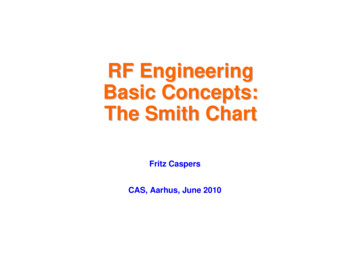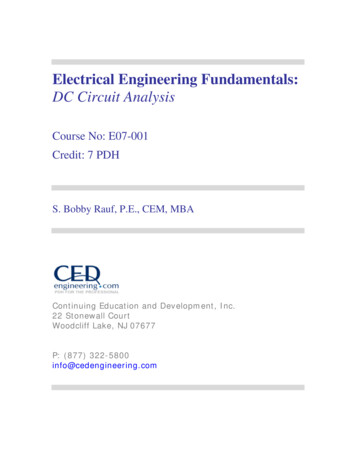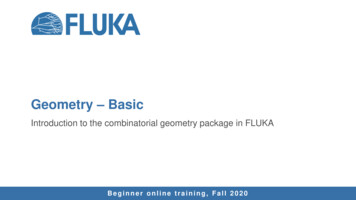
Transcription
RF EngineeringBasic Concepts:The Smith ChartFritz CaspersCAS, Aarhus, June 2010
Contents Motivation Definition of the Smith Chart Navigation in the Smith Chart Application Examples RulersCAS, Aarhus, June 2010RF Basic Concepts, Caspers, McIntosh, Kroyer2
Motivation The Smith Chart was invented by Phillip Smith in 1939 inorder to provide an easily usable graphical representation ofthe complex reflection coefficient Γ and reading of theassociated complex terminating impedance Γ is defined as the ratio of electrical field strength of thereflected versus forward travelling wave Why not the magnetic field strength? – Simply, since theelectric field is easier measurable as compared to themagnetic fieldCAS, Aarhus, June 2010RF Basic Concepts, Caspers, McIntosh, Kroyer3
Motivation In the old days when no network analyzers were available, thereflection coefficient was measured using a coaxial measurementline with a slit in axial direction: There was a little electric field probeprotruding into the field region of thiscoaxial line near the outer conductorDUT orand the signal picked up wasrectified in a microwave diode and terminatingimpedancedisplayed on a micro volt meterGoing along this RF measurementline, one could find minima andmaxima and determine their position,spacing and the ratio of maximum tominimum voltage reading. This isthe origin of the VSWR (voltagestanding wave ratio) which we willdiscuss later again in more detail Movable electricfield probefromgeneratorRF measurements like this are now obsolete, but the Smith Chart,the VSWR and the reflection coefficient Γ are still very important andused in the everyday life of the microwave engineer both forsimulations and measurementsCAS, Aarhus, June 2010RF Basic Concepts, Caspers, McIntosh, Kroyer4
The Smith Chart (1)The Smith Chart represents the complex -plane within the unit circle. It is a conformalmapping ( bilinear) of the complex Z-plane onto the complex Γ plane using the transformation X Imag( )Z Z0Z Z0withZ R jXλ/8λ/16Imag( )3λ/16Z-planeR Real( )λ/40,λ/2Real( )7λ/165λ/163λ/8 The half plane with positive real part of Z is thus transformed into theinterior of the unit circle of the Γ plane and vice versa!CAS, Aarhus, June 2010Smith ChartRF Basic Concepts, Caspers, McIntosh,Kroyer5
The Smith Chart (2)This bilinear transformation has the following properties: generalized circles are transformed into generalized circlesa straight line is nothing else than circle circlea circle with infinite radius straight line circle circle straight linea circle is defined by 3 points straight line straight linea straight line is defined by 2 angles are preserved locallypointsCAS, Aarhus, June 2010Smith ChartRF Basic Concepts, Caspers, McIntosh,Kroyer6
The Smith Chart (3)Impedances Z are usually first normalized byz ZZ0where Z0 is some reference impedance which is often the characteristic impedance of theconnecting coaxial cables (e.g. 50 Ohm). The general form of the transformation can then bewritten as z 1z 1resp .z 1 1 This mapping offers several practical advantages:1. The diagram includes all “passive” impedances, i.e. those with positive real part, from zeroto infinity in a handy format. Impedances with negative real part (“active device”, e.g. reflectionamplifiers) would show up outside the (normal) Smith chart.2. The mapping converts impedances (z) or admittances (y) into reflection factors and viceversa. This is particularly interesting for studies in the radiofrequency and microwave domainwhere electrical quantities are usually expressed in terms of “direct” or “forward” waves and“reflected” or “backward” waves. This replaces the notation in terms of currents and voltagesused at lower frequencies. Also the reference plane can be moved very easily using the Smithchart.CAS, Aarhus, June 2010Smith ChartRF Basic Concepts, Caspers, McIntosh,Kroyer7
The Smith Chart (4)Imag( ) jThe Smith Chart (“Abaque Smith” in French)is the linear representation of thecomplex reflection factor -1 1This is the ratio betweenbackward and forward wave(implied forward wave a 1)-jCAS, Aarhus, June 2010Real( )bai.e. the ratio of backward/forward wave.The upper half of the Smith-Chart is “inductive” positive imaginary part of impedance, the lowerhalf is “capacitive” negative imaginary part.Smith ChartRF Basic Concepts, Caspers, McIntosh,Kroyer8
Important pointsImportant Points: Short Circuit -1, z Open Circuit 1, z Matched Load 0, z 1 Short CircuitImag( )z 0 1Open Circuitz 1Real( )The circle 1 describesa lossless element (C or L)Outside the circle 1 wehave an active element, forinstance tunnel diodereflection amplifierCAS, Aarhus, June 2010Smith ChartRF Basic Concepts, Caspers, McIntosh,Kroyerz 1 0Matched Load9
The Smith Chart (5)The Smith Chart can also represent the complex -plane within the unit circle using aconformal mapping of the complex Y-plane onto itself using the transformation11 Y Y0Z Z0Z Z0 11Y Y0Z Z0 Z Z0with Y G jBImag( )B Imag(Y)Y-planeG Real(Y)CAS, Aarhus, June 2010Smith ChartRF Basic Concepts, Caspers, McIntosh,KroyerReal( )10
How does it look like:Answer:VERY CONFUSING!CAS, Aarhus, June 2010RF Basic Concepts, Caspers, McIntosh, Kroyer11
The Smith Chart (6)3. The distance from the center of the diagram is directly proportional to themagnitude of the reflection factor. In particular, the perimeter of the diagram representsfull reflection, 1. Problems of matching are clearly visualize.Power into the load forward power – reflected powerP a b2 2 a 1 22 1 0.75 0 .5 0.25availablepower fromthe source“(mismatch)”loss 0Here the US notion is used, where power a 2.European notation (often): power a 2/2These conventions have no impact on S parameters, but is relevantfor absolute power calculation which is rarely used in the Smith ChartCAS, Aarhus, June 2010Smith ChartRF Basic Concepts, Caspers, McIntosh,Kroyer12
The Smith Chart (7)4. The transitionimpedance admittanceand vice-versa is particularly easy. const.1/ z 1 1 z z 1 1 / z z 1/ z 1 1 z1 1 / z z Impedance zReflection z 1z 0 1 Admittance 1/z yReflection - CAS, Aarhus, June 2010Smith ChartRF Basic Concepts, Caspers, McIntosh,Kroyer13
Navigation in the Smith Chart (1)Series LSeries CSeries Lin blue: Impedance plane ( Z)in red: Admittance plane ( Y)Series LSeries CZCAS, Aarhus, June 2010ZNavigationin the KroyerSmith ChartRF Basic Concepts, Caspers,McIntosh,14
Navigation in the Smith Chart (2)Shunt LShunt CSeries Lin blue: Admittance plane ( Y)in red: Impedance plane ( Z)Shunt LShunt CZCAS, Aarhus, June 2010ZNavigationin the KroyerSmith ChartRF Basic Concepts, Caspers,McIntosh,15
Navigation in the Smith Chart (3)Toward loadCAS, Aarhus, June 2010RedarcsResistance RBluearcsConductance GConcentriccircleTransmissionline goingToward loadTowardgeneratorToward generatorNavigationin the KroyerSmith ChartRF Basic Concepts, Caspers,McIntosh,16
Navigation in the Smith Chart - Summaryin blue: Admittance plane ( Y)in red: Impedance plane ( Z)Shunt LSeries CCAS, Aarhus, June 2010Series LShunt CUpDownRedcirclesSeries LSeries CBluecirclesShunt LShunt CNavigationin the KroyerSmith ChartRF Basic Concepts, Caspers,McIntosh,17
Impedance transformation by transmission linesThe S-matrix for an ideal, losslesstransmission line of length l is given by load 0S j l e2 l ine j l 0 where 2 / is the propagation coefficient with thewavelength (this refers to thewavelength on the line containing somedielectric). For εr 1 we denote λ λ0. in load e j 2 lHow to remember that when adding a section ofline we have to turn clockwise: assume we are at -1(short circuit) and add a very short piece of coaxial cable.Then we have made an inductance thus we are in the upperhalf of the Smith-Chart.CAS, Aarhus, June 2010N.B.: It is supposed that the reflection factors areevaluated with respect to the characteristicimpedance Z0 of the line segment.Navigationin the KroyerSmith ChartRF Basic Concepts, Caspers,McIntosh,18
Transformation over a lossless transmission lineImpedance of a shortened coaxial line is given by:Z in jZ 0 tan( l citiveFrom here, we readl/λ which is theparameterization ofthis outermost circleCAS, Aarhus, June 20103λ/8We go along the red circle whenadding a coaxial line (Imaginewe have a coaxial tromboneterminated by a short and weRF Basic Concepts, Caspers, McIntosh,Kroyervaryits length)19
/4 - Line transformationsImpedance zA transmission line of length loadl /4transforms a load reflection load to itsinput as in load e j 2 l load e j loadThus a normalized load impedance z istransformed into 1/z. inImpedance1/zCAS, Aarhus, June 2010In particular, a short circuit at one end istransformed into an open circuit at theother. This is a particular property of the /4 transformers.when adding a transmission lineto some terminating impedance we moveclockwise through the Smith-Chart.Navigationin the KroyerSmith ChartRF Basic Concepts, Caspers,McIntosh,20
Looking through a 2-portIn general: in S11 Transformer with e-2βlLine /16 ( π/8):S12 S 21 L1 S 22 LInte crerm ain sinat gingre1s0were in is the reflectioncoefficient when looking throughthe 2-port and load is the loadreflection coefficient.1 inistorCAS, Aarhus, June 2010 j L4Attenuator 3dB:10z 1 orZ 50 0 82terminatingimpedanceVariable load resistor (0 z ):z 0e in L e The outer circle and the real axisin the simplified Smith diagrambelow are mapped to othercircles and lines, as can be seenon the right. 0 j 8 e j 1 in 0 2 2 2 0 2 in Lz Navigationin theSmith ChartRF Basic Concepts,Caspers,McIntosh,Kroyer2 L221
Example: a Step inCharacteristic Impedance (1)Consider a junction of two coaxial cables, one with ZC,1 50 characteristicimpedance, the other with ZC,2 75 characteristic impedance.1Z C ,1 50 Junction between aand a 75 1cable.50 KLINVILLWe assume an infinitelyshortKcable length 1 andROLLETjust look at the junction.2Z C ,1Z C ,2Z C , 2 75 Step 1: Calculate the reflection coefficient and keep in mind: all ports have to beterminated with their respective characteristic impedance, i.e. 75 for port 2. 1 Z Z C ,1Z Z C ,1 75 50 0 .275 50Thus, the voltage of the reflected wave at port 1 is 20% of the incident wave and thereflected power at port 1 (proportional 2) is 0.22 4%. As this junction is lossless, thetransmitted power must be 96% (conservation of energy). From this we can deduce b22 0.96. But: how do we get the voltage of this outgoing wave?CAS, Aarhus, June 2010ExampleRF Basic Concepts, Caspers, McIntosh,Kroyer22
Example: a Step inCharacteristic Impedance (2)Step 2: Remember, a and b are power-waves and defined as voltage of the forward- orbackward travelling wave normalized to Z C .The tangential electric field in the dielectric in the 50 and the 75 line, respectively,must be continuous.t voltage transmission coefficientZ C 1 50 Z C 2 75 in this case. t 1 This may appear counterintuitive,PE r 2.25Air, r 1as one might expect 1- for thetransmitted wave. Note that thevoltage of the transmitted waveis higher than the voltage of theincident wave. But we have tonormalize to get the correspondingS-parameter. S12 S21 viareciprocity! But S11 S22, i.e. thestructure is NOT symmetric.E incident 1E reflected 0 .2CAS, Aarhus, June 2010E transmitte d 1 .2ExampleRF Basic Concepts, Caspers, McIntosh,Kroyer23
Example: a Step inCharacteristic Impedance (3)Once we have determined the voltage transmission coefficient, we have to normalizeto the ratio of the characteristic impedances, respectively. Thus we get for50 1 .2 0 .816 0 .979875We know from the previous calculation that the reflected power (proportional 2) is 4%of the incident power. Thus 96% of the power are transmitted.Check done122S 21 1 .44 0 .96 0 .9798 1 .5S 21 1 .2S 22CAS, Aarhus, June 2010To be compared with S11 0.2!50 75 0 .250 75ExampleRF Basic Concepts, Caspers, McIntosh,Kroyer24
Example: a Step inCharacteristic Impedance (4)Visualization in the Smith chartAs shown in the previous slides thetransmitted voltage ist 1 Vt a b and subsequently the current isIt Z a - b.Remember: the reflection coefficient isdefined with respect to voltages. For currentsthe sign inverts. Thus a positive reflectioncoefficient in the normal ( voltage) definitionleads to a subtraction of currents or isnegative with respect to current.Vt a b 1.2It Z a-b-bb 0.2incident wave a 1Note: here Zload is realCAS, Aarhus, June 2010ExampleRF Basic Concepts, Caspers, McIntosh,Kroyer25
Example: a Step inCharacteristic Impedance (5)General casez 1 j1.6Thus we can read from the Smith chartimmediately the amplitude and phase ofvoltage and current on the load (of course wecan calculate it when using the complexvoltage divider).ZG 50 aa b V1B Γa 1I1 Z a-b-bI1 V1Z 50 j80 (load impedance)z 1 j1.6bCAS, Aarhus, June 2010ExampleRF Basic Concepts, Caspers, McIntosh,Kroyer26
What about all these rulersbelow the Smith chart (1)How to use these rulers:You take the modulus of the reflection coefficient of an impedance to be examined bysome means, either with a conventional ruler or better take it into the compass. Then referto the coordinate denoted to CENTER and go to the left or for the other part of the rulers(not shown here in the magnification) to the right except for the lowest line which ismarked ORIGIN at the left.CAS, Aarhus, June 2010ExampleRF Basic Concepts, Caspers, McIntosh,Kroyer27
What about all these rulersbelow the Smith chart (2)First ruler / left / upper part, marked SWR. This means VSWR, i.e. Voltage Standing WaveRatio, the range of value is between one and infinity. One is for the matched case (centerof the Smith chart), infinity is for total reflection (boundary of the SC). The upper part is inlinear scale, the lower part of this ruler is in dB, noted as dBS (dB referred to StandingWave Ratio). Example: SWR 10 corresponds to 20 dBS, SWR 100 corresponds to 40dBS [voltage ratios, not power ratios].CAS, Aarhus, June 2010ExampleRF Basic Concepts, Caspers, McIntosh,Kroyer28
What about all these rulersbelow the Smith chart (3)Second ruler / left / upper part, marked as RTN.LOSS return loss in dB. This indicatesthe amount of reflected wave expressed in dB. Thus, in the center of SC nothing isreflected and the return loss is infinite. At the boundary we have full reflection, thus returnloss 0 dB. The lower part of the scale denoted as RFL.COEFF. P reflection coefficient interms of POWER (proportional 2). No reflected power for the matched case center ofthe SC, (normalized) reflected power 1 at the boundary.CAS, Aarhus, June 2010ExampleRF Basic Concepts, Caspers, McIntosh,Kroyer29
What about all these rulersbelow the Smith chart (4)Third ruler / left, marked as RFL.COEFF,E or I gives us the modulus ( absolute value)of the reflection coefficient in linear scale. Note that since we have the modulus we canrefer it both to voltage or current as we have omitted the sign, we just use the modulus.Obviously in the center the reflection coefficient is zero, at the boundary it is one.The fourth ruler has been discussed in the example of the previous slides: Voltagetransmission coefficient. Note that the modulus of the voltage (and current) transmissioncoefficient has a range from zero, i.e. short circuit, to 2 (open 1 with 1). This ruleris only valid for Zload real, i.e. the case of a step in characteristic impedance of thecoaxial line.CAS, Aarhus, June 2010ExampleRF Basic Concepts, Caspers, McIntosh,Kroyer30
What about all these rulersbelow the Smith chart (5)Third ruler / right, marked as TRANSM.COEFF.P refers to the transmittedpower as a2function of mismatch and displays essentially the relation Pt 1 . Thus, in the center ofthe SC full match, all the power is transmitted. At the boundary we have total reflectionand e.g. for a value of 0.5 we see that 75% of the incident power is transmitted. 0.5CAS, Aarhus, June 2010Note that the voltage of the transmitted wave in thiscase is 1.5 x the incident wave (Zload real)ExampleRF Basic Concepts, Caspers, McIntosh,Kroyer31
What about all these rulersbelow the Smith chart (6)Second ruler / right / upper part, denoted as RFL.LOSS in dB reflection loss. This rulerrefers to the loss in the transmitted wave, not to be confounded2 with the return lossreferring to the reflected wave. It displays the relation Pt 1 in dB.Example: 1 / 2 0 .707 , transmitted power 50% thus loss 50% 3dB.Note that in the lowest ruler the voltage of the transmitted wave (Zload real) would beVt 1 .707 1 1 / 2if referring to the voltage.CAS, Aarhus, June 2010ExampleRF Basic Concepts, Caspers, McIntosh,Kroyer32
What about all these rulersbelow the Smith chart (7)First ruler / right / upper part, denoted as ATTEN. in dB assumes that we are measuring anattenuator (that may be a lossy line) which itself is terminated by an open or short circuit(full reflection). Thus the wave is travelling twice through the attenuator (forward andbackward). The value of this attenuator can be between zero and some very high numbercorresponding to the matched case.The lower scale of ruler #1 displays the same situation just in terms of VSWR.Example: a 10dB attenuator attenuates the reflected wave by 20dB going forth and backand we get a reflection coefficient of 0.1 ( 10% in voltage).Another Example: 3dB attenuator gives forth andback 6dB which is half the voltage.CAS, Aarhus, June 2010ExampleRF Basic Concepts, Caspers, McIntosh,Kroyer33
Quality Factor (1): Equivalent circuit of acavityZ input Z resonator Z ShuntZ g RgILVbeamRpGeneratorV0CLThe generator maydeliver power to Rp andto the beam, but also thebeam can deliver powerto Rp and Rg!BeamThe beam is usuallyconsidered as a currentsource with infinitesource impedance.Lossless resonatorR p resistor representing the loss of the parallel RLC equivalent circuitWe have Resonance condition, when Resonance frequency:CAS, Aarhus, June 2010 L res 2 f res 1 C1 LCf res 12 circuitRF Basic Concepts, Caspers,EquivalentMcIntosh, Kroyer1LC34
The Quality Factor (2) The quality (Q) factor of a resonant circuit is defined as the ratio ofthe stored energy W over the energy dissipated P in one cycle. WQ P Q0: Unloaded Q factor of the unperturbed system, e.g. the “standalone”cavityQL: Loaded Q factor: generator and measurement circuits connectedQext: External Q factor describes the degradation of Q0 due togenerator and diagnostic impedancesThese Q factors are related by111 Q L Q 0 Q ext The Q factor of a resonance can be calculated from the centerfrequency f0 and the 3 dB bandwidth f asfQ 0 fCAS, Aarhus, June 2010RF Basic Concepts, Caspers, McIntosh, Kroyer35
Input Impedance: Z-planeIm Z f f ( 3 dB )f ( 3 dB ) lower 3dB pointZ 3 dB 0 .707 R R / 2f 0f f res45 Re Z f The impedance Z forthe equivalent circuit is :Z f f ( 3 dB )111 j C Rj Lf ( 3 dB ) upper 3dB pointCAS, Aarhus, June 2010circuitRF Basic Concepts, Caspers,EquivalentMcIntosh, Kroyer36
Input Admittance: Y-planeIm Y f f f ( 3 dB )Evaluating the admittance YY 3 dB (1 / R )1 .414 (1 / R ) 2f f res45 Re Y for the equivalent circuit we get1 11Y j C Z Rj L11 j ( C ) LRf11f j( res )RR / Q f resff f ( 3 dB )f 0CAS, Aarhus, June 2010circuitRF Basic Concepts, Caspers,EquivalentMcIntosh, Kroyer37
Q-Factor Measurement in the Smith Chart The typical locus of a resonantcircuit in the Smith chart isillustrated as the dashed red circle(shown in the “detuned short”position)From the different markedfrequency points the 3 dBbandwidth and thus the qualityfactors Q0 (f5,f6), QL(f1,f2) andQext(f3,f4) can be determinedThe larger the circle, the strongerthe couplingIn practise, the circle may berotated around the origin due totransmission lines between theresonant circuit and themeasurement deviceCAS, Aarhus, June 2010Locus of Re(Z) Im(Z)RF Basic Concepts, Caspers, McIntosh, Kroyer38
Q-Factor Measurement in the Smith Chart The unloaded Q0 can be determined from f5 and f6. Condition: Re{Z} Im{Z} in detuned short position. Resonator in “detuned short” position Marker format: Z Search for the two points where Re{Z} Im{Z} f5 and f6The loaded QL can be calculated from the points f1 and f2. Condition: Im{S11} max in detuned short position. Resonator in “detuned short” position Marker format: Re{S11} jIm{S11} Search for the two points where Im{S11} max f1 and f2The external QE can be calculated from f3 and f4. Condition: Z j indetuned open position, which is equivalent to Y j in detuned shortposition. Resonator in “detuned open” position Marker format: Z Search for the two points where Z j f3 and f4CAS,Aarhus, June 2010RF Basic Concepts, Caspers, McIntosh, Kroyer39
Q-Factor Measurement in the Smith Chart There are three ranges of the coupling factor defined by Q0QextorQL Q01 This allows us to define: 1, QL Q0/2.Critical Coupling:The locus of touches the center of the SC. At resonance all theavailable generator power is coupled to the resonance circuit. The phaseswing is 180 . Undercritical Coupling:(0 1).The locus of in the detuned short position is left of the center of theSC. The phase swing is smaller than 180 . Overcritical coupling:(1 ).The center of the SC is inside the locus of . The phase swing is largerthan 180 . Example see previous slideCAS,Aarhus, June 2010RF Basic Concepts, Caspers, McIntosh, Kroyer40
RF Basic Concepts, Caspers, McIntosh, Kroyer 9. Important points Short Circuit. Matched Load. Open Circuit. Important Points: Short Circuit -1, z Open Circuit 1, z Matched Load 0, z 1 The circle 1 describes a . lossless element (C or L) Outside the circle 1 we have an . active element, for











